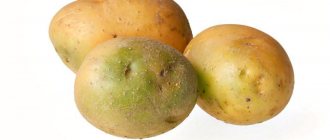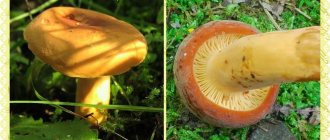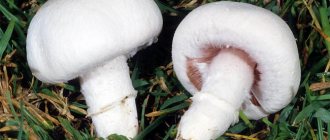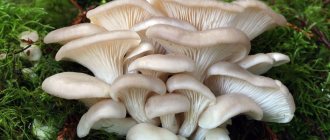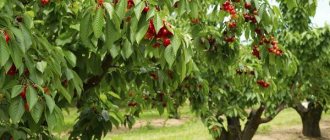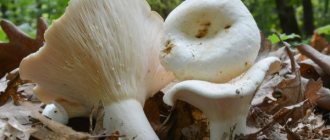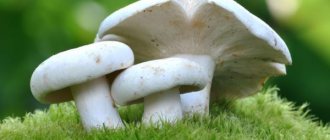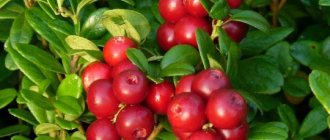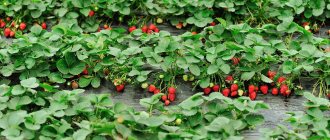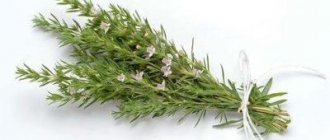» Mushrooms » Edible mushrooms » Bitter mushroom - where to look and what to cook
0
1809
Article rating
The pungent bitter mushroom is a source of doubt for many. Some consider it inedible or poisonous, others use it in medicine and cooking. To understand this, you need to familiarize yourself with its description and possibility of application.
- Application in medicine
- Growing
- In the garden
- In room
Bitter mushroom - where to look and what to cook
Description and appearance of bittersweet
The cap reaches 12 cm, and in some cases up to 18 cm in diameter, has a convex-flat shape; as it ages, it becomes like a funnel. The mushroom cap is fleshy and dry, has a brown-red matte color. There is a small bump in the center and small dents around it. In old mushrooms it is dark red. Some specimens have light small circles. The skin of the hat is thin with grooves present.
The leg reaches 10 cm in length, its diameter is 2 cm. The shape resembles a cylinder, there are no fibers. The ground on the stalk has slight pubescence. Young mushrooms have a straight and solid stem, while old mushrooms have a hollow stem. When the mushroom is young, the color of the stem is dirty white, but in older specimens it is pink or red with rusty pollination.
The pulp is very thin, but dense, the aroma is reminiscent of resin. The juice, abundantly secreted, is burning and acrid, white in color. The mushroom has a certain bitterness. The plates are frequent and at the same time narrow. In a young mushroom they have a red color with a yellow tint, as they grow older they acquire a red color with a brown tint, and in very old mushrooms a white coating appears on the plates.
Salted bitters: cold salting method
An easier and faster way to get crispy pickles. True, you need to wait at least 30 days for its results if you have a cold cellar.
Cooking time: 1 hour 10 minutes
Number of servings: 20
Energy value
- calorie content – 22.1 kcal;
- proteins – 3.05 g;
- fats – 0.6 g;
- carbohydrates – 3.4 g.
Ingredients
- bitterlings – 1 kg;
- coarse salt – 2 tbsp;
- spices - to taste;
- garlic cloves – 5 pcs.
Step-by-step preparation
- Soak the peeled mushrooms for about five days in raw, cool water. Then squeeze out excess moisture. Remove the stems from large bitters.
- Place the product along with garlic slices, spices and salt in layers in a wooden or plastic container. Fill the surface with water and install pressure. You can try again in a month.
Tip: to store the product for a long time, use the most common coarse rock salt. Spice with iodine additives is not suitable for any preparation, because it contains an anti-caking component.
Edibility of the mushroom
Bitter mushroom is a conditionally edible mushroom, that is, it can be consumed only after preliminary boiling in salted water. It is used quite rarely in cooking; mushroom pickers mainly collect them for drying, soaking or pickling. When salted, the mushroom becomes brown in color.
In the West, this type of mushroom is not eaten; the mushroom is capable of absorbing radioactive elements. Therefore, such mushrooms can only be collected in environmentally friendly places, and before cooking they must be soaked to remove the bitterness.
Cooking rules
Despite the bitter taste and not very high nutritional value, bitters are readily used in cooking - they are pickled, salted, fried and frozen for the winter.
Before preparing any dish, mushrooms must be properly processed to get rid of the pungent smell and tart taste.
After collection, the fruiting bodies are freed from forest debris, washed in clean water, most of the stem is cut off, leaving a small fragment 1 cm long under the cap.
Next, they are placed in a capacious container and filled with water. Soak for 3 days, changing the water at least twice (or better yet, do this at least 2-3 times a day). To prevent them from becoming moldy, you can add 1 tsp to the water. citric acid and 1 tbsp. l. salt. This long soaking will remove all the bitterness. Afterwards you can start preparing them.
Soaking for 3 days is usually used with the hot salting method. If a cold salting method is intended, then soaking should take place for at least 6 days. With any salting method, the water should be changed as often as possible during soaking.
There are many recipes with bitters, let's look at the most popular ones.
Recipe 1. Fried mushrooms with potatoes
Many gourmets believe that these components combine perfectly in one dish.
To prepare you will need:
- potatoes - 10 pcs.;
- mushrooms - 0.5 kg;
- black peppercorns - 5-6 pcs.;
- salt - to taste;
- spices (bay leaf, etc.) - optional;
- chopped greens (dill, parsley) - for serving.
First, soaked mushrooms need to be boiled. Pour water into a saucepan, add a couple of black peppercorns, salt, and other spices (optional). The mushroom mass is transferred to a metal bowl, brought to a boil, and simmered for half an hour over low heat to maintain their shape. During cooking, it is necessary to periodically remove the foam.
The boiled fruiting bodies are placed in a colander to get rid of excess liquid. Then peel the potatoes, cut them into cubes, and boil them in salted water.
What can bittersweet be confused with?
Bittersweet is similar to many other mushrooms, so before putting the mushroom in a basket, you should pay attention to its cap; if there is a tubercle in the middle of the cap and juice is released, then you can safely take this mushroom with you.
Bittersweet can be easily confused with the following mushrooms:
| Name of the mushroom | Description |
| Camphor mushroom | It is an edible mushroom. The smell of milk mushrooms is similar to dry tree roots. |
| Orange mushroom | The cap of this mushroom is chestnut in color and its stem is the same color. |
| Swamp milk mushroom | It also looks like bitterweed, the color of the cap is the same, it can be found near a swamp in pine forests. |
| Liver milkweed | It is considered an inedible mushroom; it differs in the color of its juice: in the milkweed it is yellow, and in the bitter mushroom it is reddish. |
| Gladysh | It is very similar to bitterweed, but there is no tubercle on its cap, and the color of the cap is chestnut-red. |
Also, an inexperienced mushroom picker may confuse bitters with:
- earrings;
- brown milkmen;
- rubellas;
- smoothies.
How to pickle bitters
Products
Bitters - 1 kilogram Sea salt - 5 tablespoons Bay leaf - 2 leaves Dill - 1 bunch Garlic - 5 cloves Vegetable oil - 1/5 cup
How to clean bitters
Wash the bitter mushrooms, clean them of forest debris, cut off the stems (you can leave only a couple of centimeters of mushroom stems), cut each mushroom in half and clean the caps and stems of the bitter mushrooms from dark areas using a knife.
How to pickle bitters
Sort out the mushrooms (small bitters are best, or large ones can be cut), soak in plenty of water, put in a cold place for 3 days, rinsing and changing the water 2 times a day.
Boil the bitters, discard in a colander and cool. Peel and cut the garlic into petals. Sprinkle the bottom of sterilized jars with salt, dill and peppercorns. Place in layers, sprinkling with salt and arranging with garlic, bay leaves, bitters with the stem up. Place herbs on top of the bitters, pour a layer of vegetable oil, screw on the lid and store in a dark, cool place. The mushrooms will settle - you can add new layers of bitters on top for pickling. Salted bitters will be ready in 40-50 days.
Where and when can you find bitterweed?
Most often, bittersweet can be found in moist soil under moss and near trees with moss. This type of mushroom can be found in the following forests:
- coniferous forest;
- Birch Grove;
- Pinery.
In particular, bitterlings love to grow under birch or pine trees. Most of these mushrooms can be found from June to October, but some mushroom pickers find bitter mushrooms before frost.
Mushrooms bear fruit consistently every year, regardless of weather conditions. Putiki grow mainly in moist, marshy soil. There are very few wormy mushrooms.
Where they grow, in what forests and how to collect
The ideal habitat for the species is a forest belt, and it doesn’t matter which one, because these miracle mushrooms feel equally good both in a dense pine forest and on the edge of a broad-leaved or mixed forest. The favorite substrate of bittersweets is slightly acidic soil with a high moisture content, so they are ubiquitous, found both on open ground and on lichens and even a dense layer of dead wood.
You may be interested in: How do edible talkers differ from false mushrooms? How many days after rain do mushrooms grow? Bitter mushroom: photo and detailed description
It is also encouraging that these mushrooms are not afraid of high temperature fluctuations, due to which they begin to appear in the forest in early June, continuing active fruiting until the first frost, and sometimes for some time after them.
You can collect bitters, which are found almost throughout the entire territory of the Eurasian continent, except for mountains and zones with permafrost, in any place except those located near busy roads and industrial enterprises. This recommendation is explained quite simply, because mushrooms, like a sponge, tend to absorb exhaust gases and harmful fumes, which does not have the best effect on their quality.
There are several varieties of bitters, but their external differences are so insignificant, as are their structural features, that they often cannot be identified with the naked eye. Moreover, many researchers believe that the varieties discovered in 1772, 1887 and 1891 are representatives of the same species, and their isolation is erroneous.
Use in cooking
Bitters must be soaked for three days, and the water must be changed twice a day to clean water. Cook the mushrooms over medium heat for 40 minutes; remove the scum that forms during cooking with a spoon. And only after these manipulations can the mushrooms be preserved or dried. Although you can find a recipe for fried bitters in books and on the Internet, this is not for everyone.
Pickling is the most common method of preparing bitters. Preference should be given to the hot salting method with the addition of seasonings.
Contraindications
In some cases, bitters can aggravate the condition of a sick person. Contraindications include:
- gastritis, increased and decreased acidity of the stomach;
- peptic ulcer;
- pancreatitis;
- various liver diseases - hepatitis, cirrhosis, liver failure.
It is also prohibited to consume mushrooms for children under 7 years of age, pregnant and nursing mothers. There is a contraindication in case of individual intolerance.
If you have at least one of these problems, you should consult your doctor about the desire and possibility of eating even occasionally bitters, like other mushrooms.
Delicious recipe! Boiled egg and green onion salad
Application in medicine
The bitter mushroom is a plant that can be used both for food and for treatment. Bittersweet contains a substance similar to an antibiotic, so in medicine the mushroom is used in bacterial treatment, and the mushroom is also able to stop the growth of Staphylococcus aureus.
In addition, bittersweet has additional properties:
- Antiseptic. Young mushrooms, like old ones, have antiseptic properties, so they can heal any wounds and cuts.
- Restores blood pressure. Bitters contains nutrients that help normalize blood pressure.
- Strengthening the immune system. Due to the fact that the mushroom contains a lot of ascorbic acid, the product increases strength and tone.
- Positive effect on the skin. Bittersweet juice can prevent skin diseases.
- Does not allow the skin to age. Bittersweet contains selenium, the mushroom prevents aging.
- Helps to lose extra pounds. The mushroom is low in calories and has beneficial properties; it can be included in the diet.
Useful and harmful properties
Bittersweet contains many substances beneficial to the human body. The younger the forest organism, the more of them there are. Mushrooms contain a large number of amino acids: tyrosine, glutamine, arginine, etc. Beneficial substances also include fatty acids: palmitic, stearic, butyric. The pulp also contains acetic acid.
Swamp milkweed contains many phosphatides and essential oils. Carbohydrate components, sugar alcohols, fiber and glycogen are present in all species related to Lactarius rufus.
The presence of arsenic causes the toxicity of some types of bitters.
Growing bittersweet mushroom
People who love these savory mushrooms can grow them in their yard, garden or even on their balcony. Growing mushrooms is not difficult and does not require large expenses. There are 2 growing methods.
- The first method is the simplest; for this you need to purchase ready-made mycelium, which is poured into a substrate that is prepared in advance. To do this, mix the bark of the tree with which the bitters are in contact with soil and sawdust. Next, holes are made next to the tree (the closer to the root, the better) and the finished mycelium is poured in, watered, and after a year you can harvest the first harvest.
- The second method is the independent collection of mushrooms, the spores of which are subsequently used for mycelium.
Bittersweet loves moisture, so the beds must be constantly moistened with plain water. If the summer is hot, then the beds provide shelter from the scorching sun.
Growing mushroom indoors
Bitters can be grown not only in the garden or garden, but also in any indoor space, be it a barn or basement. The mycelium, previously mixed with the substrate, should be placed in a plastic bag, in which holes are made, from where the mushrooms will come out.
The room temperature should be approximately 20 degrees Celsius; if all the rules have been followed, the first harvest can be harvested after 2 weeks.
The bitter mushroom is not very popular, but still some mushroom pickers collect them and pickle them hot or cold. Also, these mushrooms are often used in folk medicine for healing wounds, increasing immunity and other purposes. Mushrooms can also be easily grown at home at no extra cost.
0
0
Copy link
Pickling bitters at home
Most often, bitters are used for pickling. At home, you can pickle mushrooms in two ways - cold and hot. Before using one of the methods, bitters are soaked for several hours in warm water to remove the bitterness.
The best way is considered hot. To do this, the crop is washed under running water, cleaned, the stems are separated from the caps, the caps that are too large are cut into pieces, and the whole thing is filled with water. They are left in this state for about a week. The water they are in is changed twice a day. This procedure is performed in order to completely remove the juice, and with it the bitterness and pungent odor. Only after soaking do they start salting.
First, you need to thoroughly wash the mushrooms and place them in boiling salted water for half an hour, remembering to stir occasionally. After the required time, the oven is turned off, and the broth and mushrooms are allowed to cool, after which they are drained through a colander. Boiled mushrooms are placed in a jar or any other container and salt, pepper, garlic, and cloves are added.
Salty bitters
You can put blackcurrant and horseradish leaves on the bottom of the container and on top. A weight is placed on top of the container so that the mushrooms are constantly in the brine and cook faster. The container is left in a cool and dark place so that the souring process does not begin. Any mold that may appear is removed. You can also periodically add boiled water.
For cold pickling, bitterlings are also soaked. After this, they are thoroughly washed and placed in a container, caps down. Sprinkle salt on top and add garlic. You can also add currant leaves, cherries, horseradish, and dill.
A weight is placed on top of the ingredients to release as much liquid as possible. You can also add new ones to already prepared salted mushrooms. To do this, remove the load and drain off the excess brine, but cooking will take longer. Cold-cooked mushrooms will be ready after a month and a half.
Habitat
Bitterbush is a mycorrhiza-forming plant with conifers and birches. Most often it grows in coniferous plantings and forest areas. Prefers acidic forest soils. The species is quite widespread in most regions of our country and is one of the most common species of laticifers.
The period of mass active fruiting occurs in summer and the first ten days of autumn. It should be noted that a characteristic feature of Lactarius rufus is the ability to most actively accumulate radioactive isotopes, therefore the collection of bitterberry fruiting bodies in areas with increased radioactive background is strictly prohibited.
